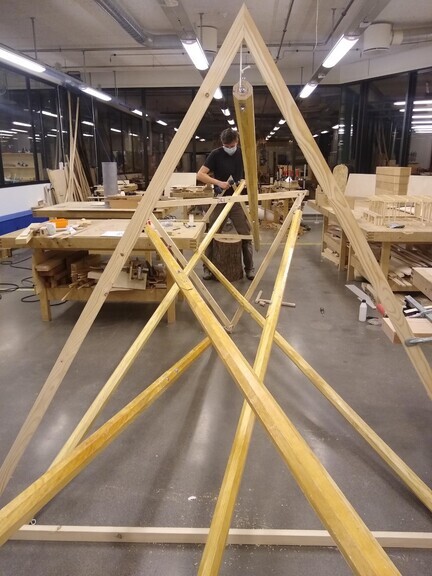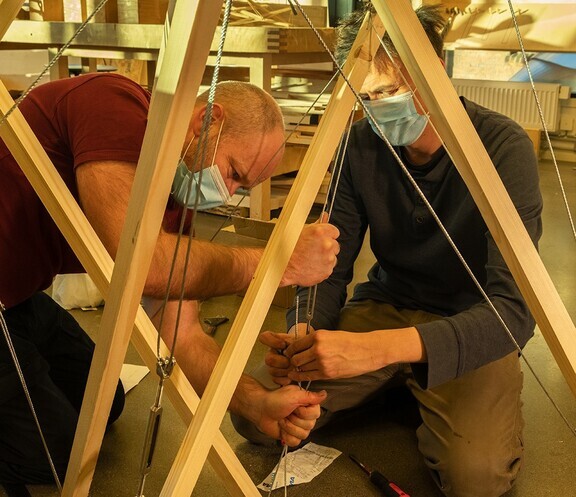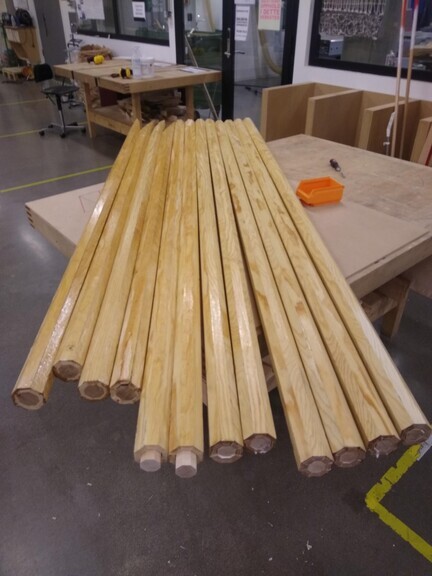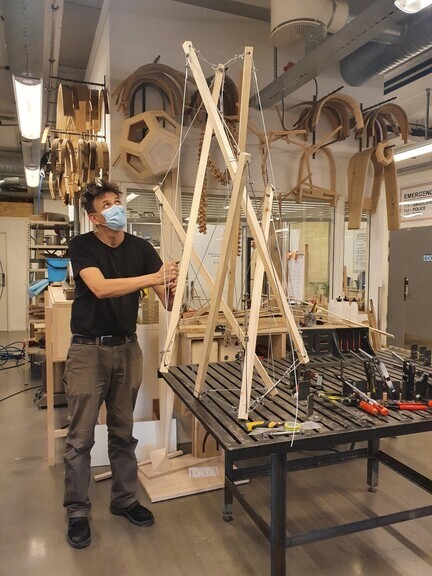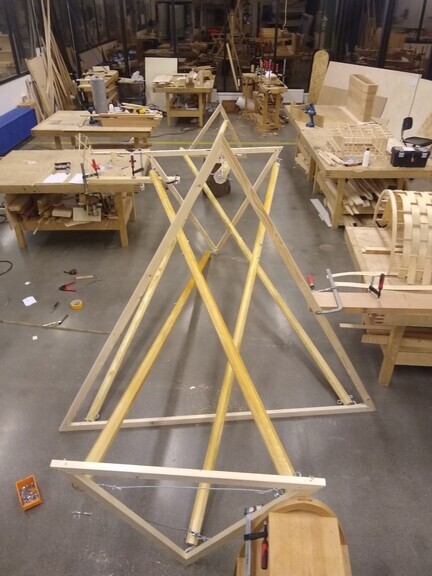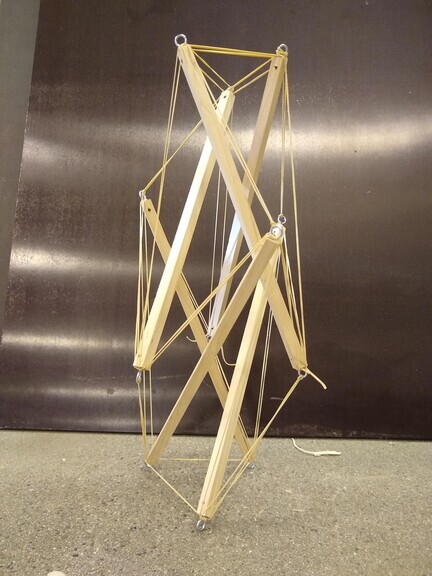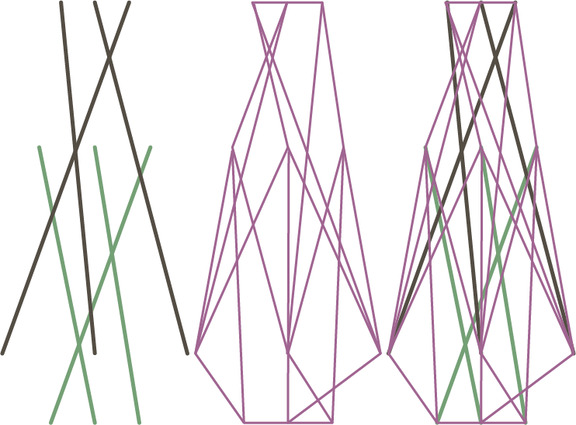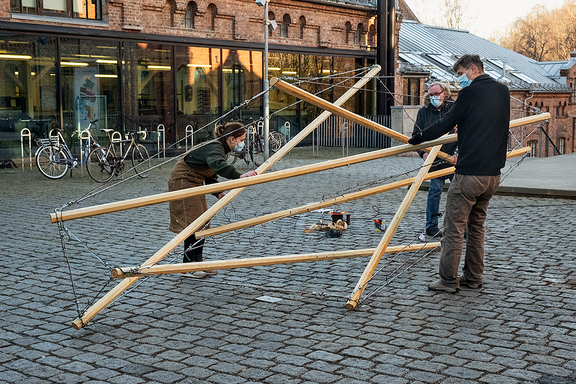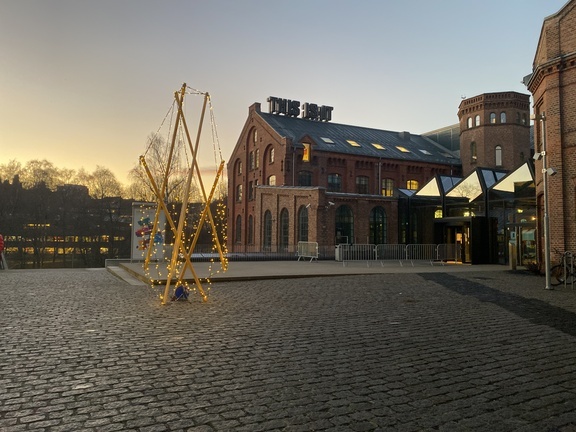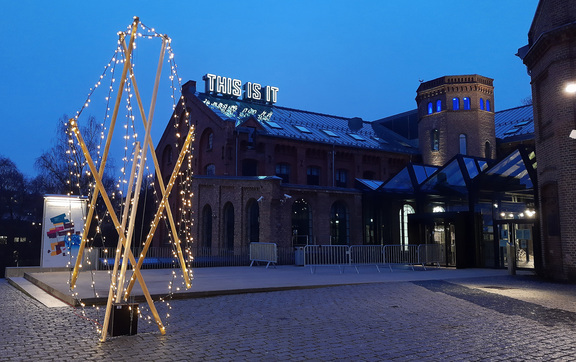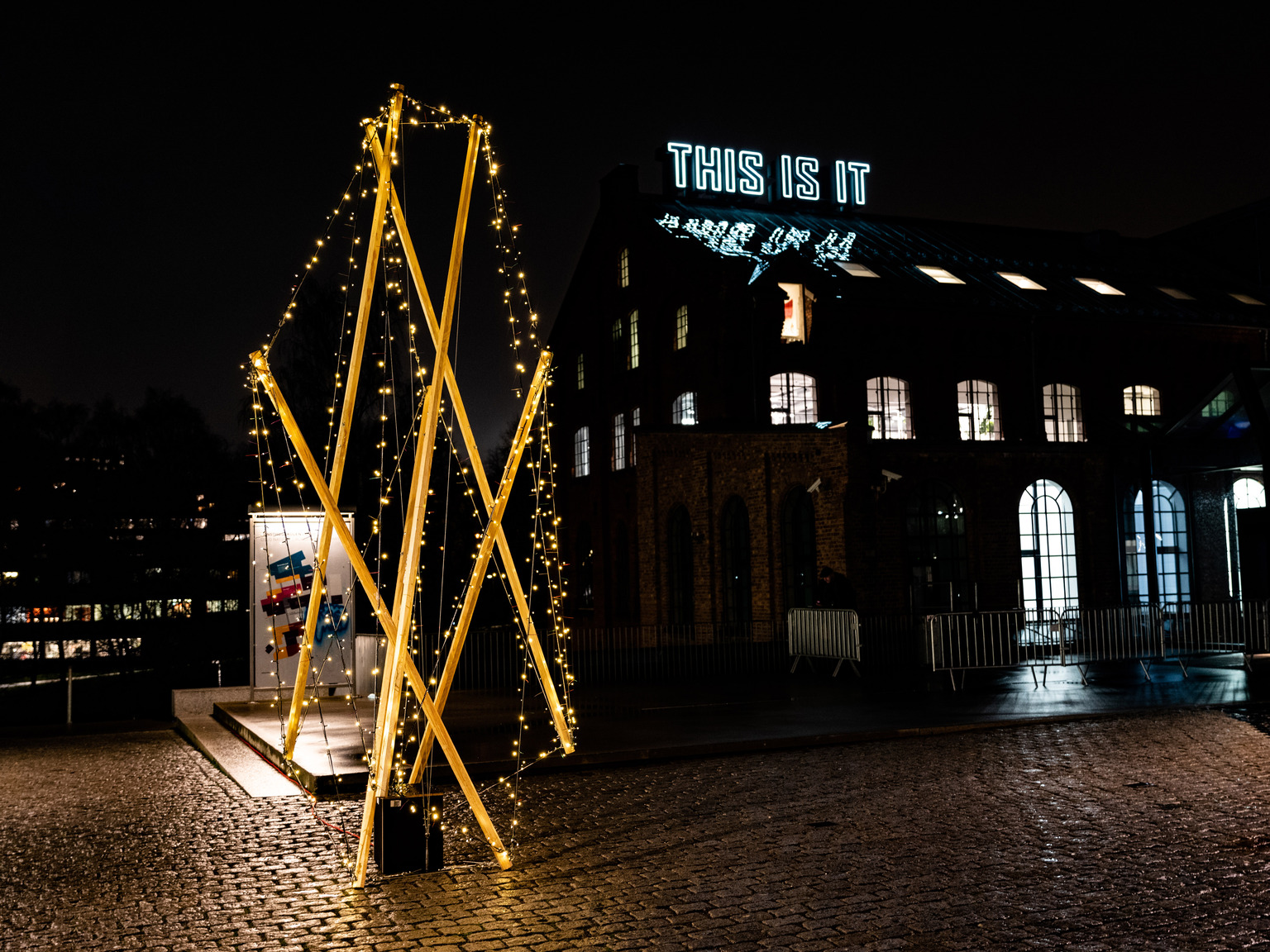
Evergreen Corona
This year, a five-metre-high and somewhat different Christmas tree will stand in the square in front of the Oslo National Academy of the Arts. The tree, named Evergreen Corona, was lit on 1 December 2020 at 15:00.
The ties that bind
It looks like we’ll be celebrating Christmas once again, this time during a year where little has been as normal. 2020 has been impacted by the ongoing pandemic and by conflicts at the Academy. Seen from the outside, it may well seem like the school is on the verge of cracking up and drifting apart.
To be sure, there have been disagreements. And indeed, at an art academy there must be disagreements. But those of us who work here, who study here, know that there is also something else. Something that helps us to come out of this demanding year even stronger – namely togetherness. For it is the ties between the disciplines, and the ties between people, that are the Academy.
Art is doing. So rather than simply chop down a tree, we decided instead to build this year’s Christmas tree from scratch. The construction is based on a principle developed by the artist Kenneth Snelson, where wooden logs hold one another up and thus hover freely in the air. Our tree will have six trunks, one for each of the six departments at the Academy. They hover freely, but they depend on one another to do so.
And now to light the tree!
Theodor Barth: Evergreen Corona
On the square outside of KHiO this year, in 2020, there is a different X-mas tree. Evergreen Corona is a sculpture using the construction principles used by sculptor Kenneth Snelson (1927-2016)
Read more ....
On the square outside of KHiO this year, in 2020, there is a different X-mas tree. Evergreen Corona is a sculpture using the construction principles used by sculptor Kenneth Snelson (1927-2016) in many of his sculptures. The titles he gave his works were simple and common, sometimes referring to places. The stairs outside of KHiO have become a local public symbol.
The idea and initiative for this year’s alternative X-mas tree is Nicolai Fontain, Worksmaster at the school’s Model- & Prototype Workshop. The sculpture is composed of 6 green wooden rods: same number as our departments at school—opera and fine arts academy, design and dance, arts & crafts and theatre. The rigid elements are joined by wire: it holds the stretch and keeps up the tree.
The title—Evergreen Corona—refers to the crown of a needle-tree. We have been, are and will be a bit “green” at this school. Both with regard to nature, the school environment and the wider world. We start with zero: always. It is our method. We want to open ourselves. No matter which subject. We trail unseen paths. We were caught in a tempest with #METOO, Corona, Black Lives Matter.
The rebellion at Evergreen College in 2017 made us think. It arose within a school with no fixed curriculum, based on individual paths of education and learning. The topic was structural racism. Like anything relating to structures it was at first difficult to discern. Both from inside and outside the school. Time was spent on understanding the rebellion. While it happened and in the aftermath.
The idea of using the tension between rigid and flexible elements to provide this year’s “X-mas tree” a sustainable structure, rests on the communication between all the elements. It defines tensegrity: an idea of integrity that can hold tensions—freedom of expression—developing new forms of contact under the restrictions of the pandemic. Wishes for a time of learning and respect.
theodor.barth@khio.no
Theodor Barth a professor of theory and writings at Design dpt. of Oslo National Academy of the Arts (KHiO)
Norsk (pdf) English (pdf) Spansk (pdf) Baskisk (pdf) Urdu (pdf) Hindi (pdf) Koreansk (pdf) Nederlandsk (pdf) Kinesisk (pdf) Polsk (pdf) Farsi (pdf) Fransk (pdf) Russisk (pdf) Sepedi (pdf) Japansk (pdf) Tyrkisk (pdf) R umensk (pdf) Islandsk (pdf) Takkeliste/Thank you note
Anne-Linn Akselsen: Evergreen Corona - Tensegrity
“Tensegrity” refers to the principles of pressure and counter-pressure, a balance between push and pull. In addition to being able to create stable structures, the same principles are also crucial to our ability to dance together.
Read more ...
“Tensegrity” refers to the principles of pressure and counter-pressure, a balance between push and pull. In addition to being able to create stable structures, the same principles are also crucial to our ability to dance together. Even the body, our primary instrument, is a structure based on tensegrity. It´s made strong and flexible through a balance of extended and compressed parts.
In every moment of dancing together, it is precisely the balance between pressure and counter-pressure that allows us to lead and follow one another, that enables us to move together, even with oppositional roles. We depend on this opposition in order to create meaningful, coordinated dances. It is not a coincidence that dancing around a tree is a festive tradition.
In a historical perspective, group dances were a powerful event that had the potential to join people across social groups. Dance has always had such a social function, with the potential to tear the social fabric and to challenge hierarchies. Dance also gives us all the chance to be a source of others’ joy, the raw material of an intense and creative interaction – such as the repetitive circling around the tree, with all the pushing and pulling, the manifest humanity in the presence of other bodies, the sweating and breathing, the joining together in movement. When we dance with others, we are forced to relate.
The evergreen corona is a static dance of elements in relation to one another. The KHiO project is also a dance full of pressure and counter-pressure, where the range of our ability to relate to one another is explored and challenged. We lead and follow one another in a dance around opinions and expressions, around freedoms and limitations, around past and present. KHiO is meant to be a place where we invite people to dance in meaningful opposition, and where there is plenty of space for everyone under the ceiling, as in Vrimla, and where there is also plenty of space sideways, as in the wings of the main stage.
And now we will light the tree in the sign of balance, as we look forward not only to the upcoming festivities but to the challenging presence of other bodies.
Wishing you a peaceful time of waiting,
Anne-Linn
Evergreen Corona – a collaboration
Evergreen Corona has so far proven to be an apt tool for inspiring conversations, dialogue and new acquaintances. A prerequisite for this tool to work is mutual respect. It is absolutely crucial to set a common goal of lifting one another up to a new and higher level.
Evergreen Corona is a collaboration between the Academy’s various departments, students and staff. Even though everyone has been so busy with the end of the semester and their various projects and classes, many students and staff have taken the time to contribute with ideas, thoughts, texts, pictures, technical assistance, know-how and craftsmanship – throughout the entire process, all the way from the initial concept and until the creation we see today. Hopefully, the project will continue to evolve.
Without all the support … We send our warmest thanks to:
Åsa Elida Wigum Skjetne, student, Kunstakademiet - Patricia Carolina, student, Kunstakademiet - Eli Mai Huang Nesse, student, Kunstakademiet - Vidar Ericsson, student, Kunstakademiet - Annalise Wimmer, student, Kunstakademiet - Victoria Alstrup, student, Kunstakademiet - Jonas Oppedal, student, design - Sam Valentin Hübner, Student, design - Mathilde Iversen Orlich, student, desdign - Jonathan Adonay Padilla Santos, student, design - Enrique Guadarrama Solis, student, kunst og håndverk - Ilayda Keskinaslan, student, Design - Ingveig Nodland, student, design - Oda Severine Lillehagen, student, design - Jennifer Lundinner, student, design - Nicolo Groenier, student, design - Young Hee Chung, student, design - Wang Xiaofeng, alumni, design - Shubham Mehra, student, design - Araitz Mesanza, student, design - Alejandra Aguilar Caballero, student, kunst og håndverk - Dariusz Wojdyga, kunst og håndverk - Farhad Kalantary, kunstner - Natalia Korotkova, alumni, design - Sana Khan Niazi, student, design - Trond Mikkelsen, teamleder, verkstedene - Isak Wisløff, høgskolelektor, design - Patrick Grung, høgskolelærer - Bjørn Blikstad, ph.d., design - Vilde Rapp Riise, møbelsnekkerlærling, verkstedene - Elin Hedberg, verksmester, verkstedene - - Tom Trøbråten, verksmester, drift - Vidar Iversen, teamleder, drift - Pål Stephensen, direktør - Atle Faye, teamleder, kommunikasjon - Martin Lundell, professor, design - Karen Disen, høgskolelektor, design - Theodor Barth, professor, design - Anne-Linn Akselsen, prorektor, førsteamanuensis, dans - Brynhild Seim, verksmester, verkstedene - Marius Arne Larsen, scenemester, sceneteknisk.
Nicolai Fontain
Facts about Evergreen Corona
Evergreen Corona is the Oslo National Academy of the Arts’ Christmas tree for 2020. Standing in the middle of the Academy’s campus at Fossveien 24, the five-metre-high sculpture is visible from the nearby Birkelunden park, from the entire length of Seilduksgata (the street leading up to the Academy) and from the bridge across the Akerselva river in the opposite direction. The Christmas was lit on Tuesday, 1 December 2020 at 15:00, and will stay in place into the new year.
Idiom / symbolism
The sculpture consists of six struts that may symbolise the six departments at the Oslo National Academy of the Arts. Rather than being in direct physical contact with one another, these six struts are connected through an intricate system of wires. The entire construction depends on all the components, and it enables three of the struts to float/hover in the air without any contact with the ground – “we lift one another up”. If any one of the components were to break or snap, the entire sculpture would crash to the ground.
Why make this Christmas tree?
KHiO has been and continues to be the focus of much media attention, and this is a nice feel-good story about collaboration. The sculpture has been built by students at the Fine Art programme at the Academy of Fine Art and students at the Bachelor of Interior Architecture and Furniture Design programme at the Design department.
What is the source of inspiration?
The principle of construction is based on the American artist Kenneth Snelson’s structural investigations and sculptures. He developed the concept of tensegrity, which consists of the type of compressions and tensions to be found in every construction. Tensegrity highlights where such structural compressions and tensions manifest themselves. Osaka is a sculpture that Snelson created in 1970, and Evergreen Corona is greatly inspired by this work.
Press contact and information: Atle Faye (tel. +47 913 47 369, e-mail atle.faye@khio.no)

